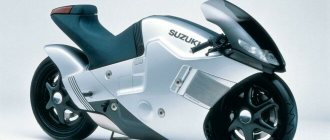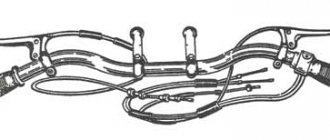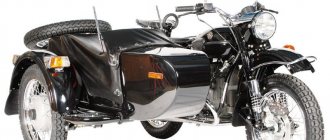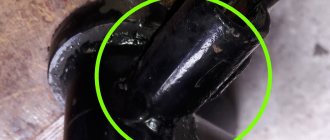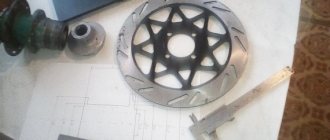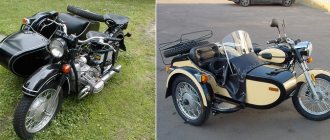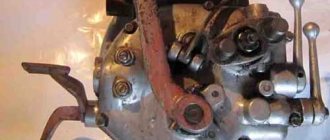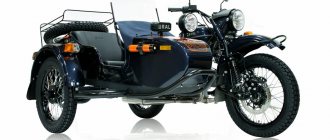On impassable Russian roads, only tanks and 3-wheeled motorcycles produced at the Irbit Motorcycle Plant are not afraid of dirt. Talented factory designers managed to create reliable, modern equipment intended for professional travelers and extreme drivers - the Ural “Tourist” motorcycle.
Ural Tourist is a Russian motorcycle with a sidecar and 19-inch wheels. A stylish bike allows you to easily and comfortably travel over rough terrain, which is especially appreciated by lovers of outdoor activities, fishing and hunting.
Ural Tourist
Purpose
In the Russian outback, the Ural “Tourist T” has become a desirable and, importantly, inexpensive “trophy” for avid bikers, hunters, fishermen, farmers and foresters. A durable front suspension will ensure fast and trouble-free driving on forest paths and curved paths, damaged asphalt and potholes on the highway. Without much difficulty, a 335-kilogram transport with a sidecar overcomes rough terrain with viscous soils or swamps.
Three passengers (with backpacks and luggage, total weight up to 285 kg) riding this massive motorcycle will get a lot of pleasure from an active holiday spent together with the “Tourist”. Its maximum speed is 120 km/h, which the bike can only reach on a good road.
Number of powered Tourists produced in the early 90s
Now I’ll tell you everything in order.
Quote:
Anton, what kind of rumors are there that your drive had a differential lock??? It's really? How asymmetrical is the differential? So the same as on MT - 19:11? I didn't have a block; and it’s probably technically impossible to stick it there. Unlike the Dnieper Bridge, where everything is there for this, you only need to install the coupling, fork and its axle. In this case, the right axle shaft there is blocked with the differential cup and the moto turns into a tank :))) Passable and almost uncontrollable :))) The Ural differential is also asymmetrical, but the power ratio is greater: that is, the rear wheel pulls stronger, and the sidecar is weaker (there is no exact ratio I remember). In my opinion, it turned out worse, because quite often there were situations when the rear wheel broke into the axle box, and the stroller was silent. On the Dnieper drive, the relationship is more harmonious: there, unless, of course, the stroller was lifted into the sky, the wheels usually began to slip at the same time.
Quote:
Instead of a differential gearbox without changes, is it possible to install a hard-wired one from a herap? Interchangeable one to one without alterations.
Quote:
It’s just that the Ural one is implemented much simpler than the Dnieper one and I see it as much more reliable. Not quite like that... It wasn’t much simpler, but it had several design and system flaws. The differential cup had a thin openwork shape and was frankly weak. In hard off-road conditions, it easily cracked and fell apart, tearing the axle housing itself. The planetary gear of the right axle shaft is also stunted; in fact, all the destruction often began with it. The satellite cover was attached to the cup with countersunk screws, the same as on the clutch. Even when installed with red thread sealant, they regularly and inevitably unscrewed. To remove the rear wheel, on early versions it was necessary to unscrew the transverse driveshaft. Subsequently, the design of the drive fork was changed, and it became possible to unscrew the axle nut using a specially sharpened 22mm wrench without separating the cardan. But at the same time, it was necessary to hang the stroller wheel so that it could spin after the nut. The monumental cardan did not twist, which negatively affected the smooth running of the structure as a whole. And most importantly. The crosspieces of the transverse cardan worked (in fact, they continue to work in modern drives!) at a significant angle. And despite the fact that the crosspieces there are Zhiguli, they are enough for about ten thousand kilometers. I bought expensive branded crosspieces, used magic metal-clad lubricants, but still the results were better than 20 thousand km. I have never been able to achieve it. I note that on a plug-in drive the crosspieces last much longer; but only because most of the time they work idle, without transferring the load.
The Dnieper drive is better designed, and the parts there even look stronger and more powerful. This is understandable: even a thousand Ukrainian engineers cannot completely destroy the potential inherent in the R75 “Sahara” (namely, the design idea goes back to it). But the quality of metalworking and especially assembly... completely negates the legacy of the “gloomy Teutonic genius”. Well, what can I say, everyone already knows everything about the Dnieper :)))) The Ural unit is much better quality. And in general, the Irbit technical school is higher than the Kyiv one IMHO.
An important advantage: the Ural Bridge uses a standard main pair, the same as on all other mono-drive boxers. So if anything happens, there is no problem with spare parts for repairs. In the Dneprovsky drive, the driven gear is original, and where the hell can you find it? In addition, its inner surface acts as a roller bearing raceway; and in the Urals these parts are separated.
In the civilian versions MT-12 and MT-16, the transverse cardan is thin. It works with an overdrive gearbox and acts as a torsion bar, which dampens the impacts of the stroller wheel. The crosspieces on it, although small, stand straight and are protected by covers. Their durability is quite decent.
At the same time, pouring oil into two cavities in the Dnieper Bridge is not technically justified at all. And let’s not forget about the wheelchair bridge, in which the oil also needs to be changed. That is, there are more hemorrhoids with maintenance. In the Urals, there is one hole into which you pour 120 ml, and everything is fine.
In general, there are both advantages and disadvantages here and there. At one time I made a choice in favor of the Ural drive, and stuck with it until the end.
Equipment and technical characteristics
Specialists of the Irbit plant equipped their main universal motorcycle Ural “Tourist T” with imported parts and components of high quality:
- carburetor from ;
- brakes from the Brembo brand;
- rear shock absorbers of the Sachs brand;
- telescopic front forks from .
Agricultural workers and rural residents will appreciate in practice the quality of the driver's mudguards, comfortable passenger handles and reliable parking brakes with a windshield, which are included in the additional equipment of this motorcycle. Manufacturers offer owners to purchase wheels with off-road tread (for improved cross-country ability) and a road kit with tubes of lubricants and oils.
The motorcycle will be a good gift for true connoisseurs of domestic technology.
A spacious, water-resistant case will be the icing on the cake. A 2.5-meter Ural “Tourist T”, having a height of more than 1 m and a width of 1.7 m, can easily fit under it. The black color of the motorbike and spoked 19-inch wheels give it brutality and additional power, which the “Ural” does not too needy. A 2-cylinder four-stroke engine with a volume of 750 cm3 and a power of 45 l/s, as well as a 4-speed reverse gearbox and a fuel tank with a capacity of 19 liters of gasoline are its main technical advantages.
| Engine capacity | 745 cc cm. |
| engine's type | 4-stroke, 2-cylinder, opposed |
| Number of gears | 4 + 1 rear |
| Power | 30 kW |
| Torque | 57 Nm |
| Dimensions (LxWxH) | 258x170x110 cm |
| Clearance | 173 mm |
| Gas tank volume | 21 l |
| Fuel consumption | 7.6 l |
Motorcycle Ural Tourist
Since 2021, orders for production are no longer accepted. It occupies a special position in the Irbit motorcycle model range. It is safe to say that it is a true “classic of the genre.” These legendary motorcycles were very popular with our fathers and even grandfathers due to their excellent driving and performance characteristics, high cross-country ability, high power and unpretentiousness. Probably, such a successful combination of all these qualities was a consequence of the fact that its not so distant ancestor was the excellent development of the German company BMW - R71. However, we must also pay tribute to the engineers of the Ural enterprise, largely thanks to whose efforts “Ural Tourist” is constantly being improved and is in constant high demand (though in recent years, mainly in foreign countries).
“Ural Tourist” is a classic heavy motorcycle with a sidecar, which is designed for traveling long distances, including over rough terrain. At one time, it was these machines that formed the basis of the motorcycle fleet of the USSR State Traffic Inspectorate, and ordinary citizens of the country used them with constant success for fishing, hunting, and traveling around the countryside with its “famous” roads. Often, craftsmen adapted the “Ural Tourist” for transporting various large-sized cargo, and exploited these “workhorses,” as they say, to the fullest extent: fortunately, the safety margin of these vehicles is truly unique.
In recent years, engineers at the Irbit Motorcycle Plant have been constantly improving this famous model, and achieving very good results. First of all, it should be said that the latest Tourist models are equipped with new four-stroke two-cylinder engines with a power of 45 l/s and a displacement of 750 cc. This allows the updated motorcycle to accelerate on the highway to a speed of 120 km/h. As noted by those who managed to try the new Ural Tourist, as they say, in practice, the increased engine power contributes to even better cross-country ability of the motorcycle, thanks to which you can feel absolutely confident on it not only on the highway, but also when driving over rough terrain. The Tourist tank holds 19 liters of fuel. This is enough to drive about three hundred kilometers at one gas station in the city cycle, and about four hundred on the highway. The gearbox of the Ural Tourist motorcycle is four-speed, allowing you to engage reverse gear. The torque is transmitted to the rear wheel using a driveshaft, and the wheels themselves are 19 inches in size.
Particularly noteworthy is the braking system of this versatile motorcycle. In accordance with international standards for equipment of this level and class, the front wheels of the Tourist are equipped with hydraulic disc brakes, and the rear wheels are equipped with drum brakes, which can significantly improve driving safety. For the convenience of the driver and passengers, the motorcycle seats are made separate and have double adjustment. As standard, the Ural Tourist is equipped with a painted trunk, which is installed on a spare wheel attached to the stroller, handles that are convenient for the passenger to hold while moving, as well as a parking brake. In addition, at the request of the customer, the motorcycle can be equipped with an off-road kit, consisting of crankcase protection, an exhaust system raised to a greater height, and front and rear sidecar protection. The manufacturer also offers a waterproof cover and all-terrain wheels as additional accessories. As for the colors of the “Tourist”, the following standard options are offered: black and black with circus, blue (“Baltic”), “green garden”.
It should also be noted that the updated Ural Tourist is equipped with a number of components and parts produced by the world's leading companies. For example, a DENSO generator, a Ducati microprocessor ignition system, Sachs shock absorbers, a Yuasa battery. All this significantly improves the driving performance of the motorcycle and significantly increases its reliability.
Modifications
The diverse motorcycle fleet of IMZ was decorated with new modifications of the “Tourist”:
- The khaki-colored “uniform” and special equipment are the distinctive features of the “Gear-Up” heavy motorcycle, which has been in service in the Russian Armed Forces for almost 18 years.
- Going for export, Ural “Retro”, which is still successfully sold in the car market of Western countries. It is created on the basis of the basic model of the "Tourist".
- Ural "Tourist 2WD", equipped with all-wheel drive.
- Choppers are one of the design ideas of IMZ. For example, the “Wolf” model is available with an extended frame and front fork.
- “Tourist T” is the main novelty of Uralmoto for the last 10 years. This motorcycle model, intended for foreign buyers, has become the most popular and sought-after brand of heavyweight bike “over there.”
WHEELS AND TIRES OF MOTORCYCLES “URAL”, “DNEPR”
The wheels of the Ural and Dnepr motorcycles are interchangeable. In Fig. 5.12 and 5 13 show disassembled wheels of the Dnepr and Ural motorcycles.
Wheels are repaired if there are cracks in the rim, if the brake drum and bearing bore are worn. Wheel maintenance comes down to timely washing and lubrication of bearings, adjusting them, monitoring spoke tension, monitoring and maintaining tire pressure. The knitting needles should be tensioned evenly and fairly tightly. The degree of tension of the spokes is determined by the sound. A sign of weak tension is a low sound tone.
The condition of the bearings in the wheel hub is checked by rotating the tightened axle and rocking it in the wheel. The axle should rotate easily without noticeable play, clicks or jams. When the wheel rotates, radial and lateral runout is permissible: for the wheel rim - no more than 2 mm; for a tire, the lateral runout is no more than 3mm, the radial runout is no more than 5mm.
Rice. 5.12. Motorcycle wheel “Dnepr11” with tire: 1 — wheel assembly, 2 — nipple, 3 — spoke; 4 - wheel housing; 5 — washer, 6 — right bushing, 7 — bearing; 8 — bushing; 9 — left bushing, 10 — nut, 11 — oil seal assembly; 12 - nut; 13 - reflector; 14 — cotter pin, 15 — nut, 16 — rear wheel axle; 17 — front wheel axle; 18 - rim; 19 — tire
Rice. 5.13. Wheel of motorcycles of the "Ural" series: 1 - wheel body with a steel hub and brake drum; 2 - thrust washer; 3,4 - right and left spacers; 5 — hub nut assembled with oil seal; 6 — spring and oil seal; 7 - nut; 8 — rim; 9,10 - axle of rear and front wheels; 11 — axle nut; 12 - nipple; 13 — knitting needles; 14 - wheel without tire
• WHAT ARE THE SIZES OF RIM AND TIRE?
The system for designating wheel and tire sizes in inches is still used today. The first number indicates the width of the tire profile when inflated (for the rim, the width). The second number shows the clear diameter of the tire (rim diameter).
The sizes of motorcycle tires are shown in the table.
Table 5.4
Tire sizes, inch
| Tire sizes, mm | Rim sizes, inch | Rim sizes, mm | |
| 64-405 | (2.50-16″) | 40-405 | (1,85-16″) |
| 80-405 | (3,25-16″) | 47-405 | (1,85-16″) |
| 110-432 | (4.00-17″) | 70-432 | (2.75-17″) |
| 80-459 | (3,00-18″) | 47-459 | (1,85-18″) |
| 90-459 | (3,50-18″) | 55-459 | (2,15-18″) |
| 60-484 | (2,25-19″) | 31-484 | (1,25-19″) |
| 65-484 | (2.50-19″) | 40-484 | (1.60-19″) |
| 80-484 | (3,25-19″) | 47-484 | (1,85-19″) |
| 95-484 | (3,75-19″) | 55-484 | (2,15-19″) |
• HOW TO INSTALL A NEW WHEEL RIM ON AN M67 MOTORCYCLE?
The main difficulty when installing a new rim is the correct installation of the spokes. The work should be done on a workbench. First you need to insert the spokes into the holes of the hub on one side. Then take two adjacent knitting needles and point the right one to the left and the left one to the right so that the knitting needles intersect. After this, insert the ends of the spokes into the first and eleventh holes of the rim (there should be nine free holes between the spokes). Now you need to insert the remaining spokes of this side of the hub into every fourth hole of the rim as shown in Fig. 5.14. There should be three free holes between the spokes of the same direction. Secure the inserted knitting needles with nipples, turning them halfway.
In order to install the spokes on the other side of the hub, you need to lift the rim and press firmly on the hub, recessing it as much as the spokes will allow. Then turn the wheel over and insert the spokes into every fourth hole as in the previous case, tighten the nipples.
Rice. 5.14. Assembling a Ural motorcycle wheel
HOW TO FACILITATE THE WHEEL ASSEMBLY PROCESS?
When replacing spokes, rim or hub, a simple device helps to assemble the wheel (Fig. 5.15, 5.16). The wheel needs to be placed on it, having first slightly adjusted it. Insert wheel hub 8 into the central hole and insert rear wheel axle 9 into it. Place washer 6 on the axle and secure with nut 5. Tighten wheel rim 2 with clamps 1 and tighten all spokes evenly, starting with the short ones. Assembly accuracy will be guaranteed, and little time is required.
Rice. 5.15. Device for assembling a wheel. Remove the clamps Fig. 5.16. The wheel is installed in the device: 1 - clamp; 2 rim; 3 - spoke; 4 — hub; 5 - nut; 6 — washer; 7 - centering protrusion; 8 — bushing; 9 - axis; 10 - bolt; 11 - nut
content .. 51 52 53 ..
